New York Produce Show Discussions: Up-and-Comer Ted Taylor of Taylor Farms Sees Optimism in Produce After Pandemic
January 27, 2021 | 16 min to read
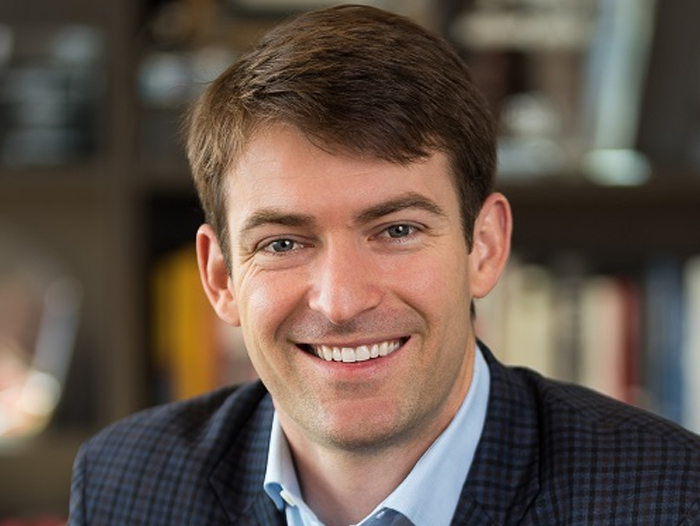
A highlight of the recently completed virtual edition of The New York Produce Show and Conference was an all-star collection of industry insight. We started out with our Pundit coverage of the show’s extra content with this piece: Sysco’s Juliet Olivarria Comes Through A Pandemic With Grace And Sees Strength In A New Future. These are robust discussions as we discuss both what has happened and what the future may yet bring.
Today we share a conversation with Ted Taylor, Head of New Ventures & Business Development at Taylor Farms. We appreciate the willingness of Taylor Farms to help advance the industry by sharing Ted’s experience and insight. You can read the text of the discussion below or watch the video beneath the text.

Ted Taylor
Head of New Ventures &
Business Development
Taylor Farms
Salinas, California
Q: We’re here today with an industry luminary who’s an up-and-coming person doing a lot of very important things. We’re honored to have Ted Taylor here with us. And Ted, why don’t you tell us a little bit about your background … who you are and how you came to be doing what you are today?
A: Absolutely, Jim. Obviously, first and foremost, it’s a pleasure to join you and be on the program. Obviously, I have deep respect for you and what you’re doing. A little bit of background on me: Born and raised in the Salinas Valley. I went to Berkeley for undergrad. Went and worked for Taylor Farms, the family business, for a few years and then moved to Boston and on to business school at Harvard.
Then went to Mission Produce, the avocado company, and moved to Europe and helped lead their expansion efforts. And then got recruited back to Taylor Farms, the family business. So born and raised in Salinas and now I’m back in Salinas.
Q: That’s great. Well, maybe you made a mistake. If you had stuck with Mission, maybe you would have gotten some stock options and hit their big public offering this year.
A: Yeah, hindsight is 20/20 there, Jim.
Q: I appreciate you being here and, of course, we’re talking to people all over the industry. And so our first step is to understand the current pandemic and when that started and all this… what kind of impact that had on different businesses around the industry.
Your company is a broad one. They do a lot of things. Can you just give us some little thought? Let’s go back to March and all of a sudden, you must start hearing things, getting calls from customers, foodservice, retail. What was it like in March?
A: You’re going to make us relive this, aren’t you? [laughs] Tail end of March, early April, wow… there was real concern about where things were going, not just for our business, but for everyone overall, right? If you look at kind of your planning of how you’re going to structure your business as you move forward, there was a lot of unknown.
And so we literally had a war room set up. We had whiteboards up and basically we had our management team there saying, “Hey, how are we going to manage through this crisis?” It was an interesting experience for me, a few years removed from business school. There’s a number of cases about crisis management that they teach you, but they don’t teach you about a global pandemic. So there weren’t a lot of tools to pull out of the tool chest, if you will.
What we were faced with was managing a business that looked dramatically different than it did a month prior. And that’s a real challenge. In the fresh produce space, that’s a real challenge.
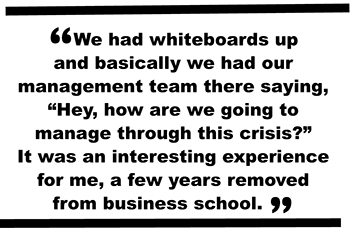
So a few things that we had to do… Obviously, number one was keeping our folks healthy and safe. As an essential business strategy, we had to keep producing food for the country. And so we were trying to adapt to ever-changing recommendations from the medical community because people didn’t know, right?
We didn’t really know…it was masks and then it was six feet apart, and so we were constantly trying to iterate and design around how to keep folks safe in both the field and in our processing plants. And I don’t need to tell anyone, a processing plant isn’t designed for six feet of space for folks. And so when you’re dealing with square inches in your design criteria, you have to rethink the whole layout. And so that was probably the biggest challenge to start was how are we going to keep people safe? How are we going to keep operating? And then obviously, there were a number of other ramifications around raw product overhangs and gaps that we can get into as we move forward here.
Q: What about the customer base? Obviously, Taylor both serves retail and foodservice. What were they telling you? Were they asking you for things? Retailers demanding more product? Foodservice saying, “How can we get out of our contract with you?” I mean it must have been pretty tough.
A: We’ve built a great trust with our customers, and we view it as a partnership in each of those selling channels. And so we approached this as kind of a family, right? And honesty and transparency are the best policy. But you’re right. If you look at the retail selling channel, there was general fear about stockouts.
And so consumers were doing panic buying; then our customers were doing more than anticipated ordering. Our run rate was probably 125 percent of average on the retail side. Where it really got challenging was the club stores. So the Costcos and Sam’s Clubs of the world… that number was even higher than 125 percent. And you’re looking at large-format products, and so you need a ton of raw product to fill that extra demand. And so that was a real challenge.
And then on the other side of the coin was the foodservice and deli worlds, where we went from 100 percent of what we anticipated in foodservice to 50 percent the next week. Obviously, the ordering just stopped. And so that normalized after about four to six weeks to about 75 percent of normal, 80 percent of normal. But just working through the product overhang that we had on the foodservice side was a real challenge for our team. And then, obviously, securing the right raw product supply for the retail increase was another challenge we were faced with.
Q: Were you able to switch some of the product that was designed for foodservice use into retail or are they too different?
A: It was interesting. The product mix was dramatically different, right? So we had an exposure of … I want to say about $35 million worth of conventional iceberg and conventional broccoli … and there was very little demand for that, right, in our traditional selling channels. All the while, you obviously had a huge uptick in the organic spinach, the organic spring mixes, the organic romaines on the retail side.
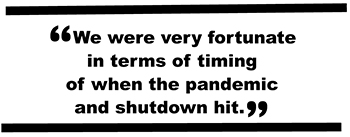
I think we were fairly fortunate in that there were a couple things going on. For the product overhang on the conventional side for foodservice, the freezer business actually took off. And so that became kind of a logical new selling channel for us as people were stocking up. The commodities at foodservice we were able to move some of that to commodity on the retail sides. We were able to shift selling channels there. And then there was actually a decent outside market, so we were able to sell some on the open market. But we still took a fairly meaningful write-off on that side.
In terms of the retail gap, I think we’re fairly fortunate that during the end of March, April timeframe was the transition back to Salinas. And so during springtime, there’s historically some extra acres out there in the market. And so we were able to secure those. We were able to save a number of acres down in the Yuma area and the Huron area and the Mexico area for second cuts. All the while, we were able to pull some of that Salinas acreage up. So we were able to fill those gaps, really focusing on maximizing yield in all those four growing areas. We were very fortunate in terms of timing of when the pandemic and shutdown hit.
Q: You happened to mention some of the organic product, and people have reported high demand for that. Is your understanding of this that it is just a function of people wanting anything at that time, and they would simply take more organic? They’d take anything? Or is it really a health concern and so forth that was leading to people preferring organic?
A: Yeah, great question. And I’m not sure we’ve got a firm answer. I would probably make the argument that both things are going on. Obviously, we continue to see transformation and morphing of demand toward the organic side. But I remember vividly going into a Costco in early April, and I think there was one cut of pork on the shelf. And I was like, “That looks great for dinner.” And so when you have one option, it sounds like a great option!
Q: During the course of this, you mentioned the priority of taking care of your staff. What was the attitude of the staff? Were they all happy to come to work? Were they afraid to come to work? What about people who would’ve come to work, but they lived with their grandparents and they were worried about them? What was the general feeling out there?
A: It’s been a mixed bag, to be honest. I think we’ve had a number of folks who have great confidence in what we’ve done with staging shifts, with running overtime, with running on Sundays, trying to limit the number of folks who are on a processing facility at any one time or on a harvesting crew at any one time or even in the office at any one time.
There has been that group that was fearful of their health and safety but also their loved ones, and we made arrangements for those folks. And we felt like the right thing to do was if you weren’t comfortable coming to work, stay home, and we’ll take care of you. And so that’s just part of who we are culturally. We look at ourselves as a big family with 22,000 employees. And our objective was to do the right thing for them. Make sure they’re safe. Make sure they’re healthy, all the while producing food for the country.
Q: After a period in which we had a sort of panic, we sort of seemed to get into some regularity and calmness. But recently, of course, the numbers have been up again on COVID. Governmental authorities have been putting in new rules. What’s the situation today in your area and what did you learn from the past few months that is making this current resurgence somewhat easier to deal with?
A: We feel like we’re well positioned, obviously, given the diversification of our selling channels and our sourcing. But it’s a real challenge, right? You look at the foodservice business, and it felt like it was finally starting to get its legs back. It was at 80, 85 percent of normal.
The new shutdowns will obviously negatively impact that. There appears to be a little bit more of an uptick in terms of the retail club store volume going back up, a little bit more of the panic buying that we saw early on. But we’re obviously super hopeful about the vaccine information that’s coming out. We think that that’s obviously going to be really impactful.
But we’re just trying to adapt to what we believe is the new normal. Obviously, costs have gone up. The cost of labor has gone up. There’s been real challenges at the border with the H-2A Program with hiccups with processing. Packaging materials have gone up. There’s an incredible demand for home delivery. And obviously, Amazon’s doing really well so there’s strong outside demand for corrugated packaging. So we just took on a six percent increase in corrugated pricing. So we’re looking at a new cost structure as we move forward, and I think that’s probably our new reality for at least a short to medium term.
Q: You know, Ted, obviously there are a lot of people at Taylor. I think of you, though, being in charge of new ventures and business development… I somehow imagine all of this is falling on you and they’re now saying, okay, Mr. Genius, tell us what should our new ventures and how should we develop this business now that we know about this world?
How does it change the kind of things you’re pursuing and the direction you’re going to go now that you’ve lived through this and you’ve seen this? And let’s assume we’re going to reach a post-pandemic future with these new vaccines and so forth, even if it takes six months or a year. What is the future that is going to guide you?
A: And that’s a great question. Obviously, there’s a lot of different layers involved in that. I think at the end of the day, we feel pretty good about where we are positioned in the healthy food category, right? Focused on convenience, health, freshness for folks, we’re going to continue to do what we do well.
Having said that, I think there’s a lot of opportunities out there that the pandemic has created. Some I don’t want to talk about because I want to keep them secret. [laughs] But as you probably know, the pandemic has impacted a variety of businesses in different ways. Some folks have been able to weather the storm quite well. Others have really struggled. And so when that happens, right, there’s opportunity.
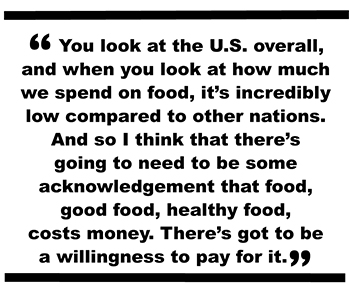
But we believe that the American consumer will continue to prioritize eating more fruits and vegetables because the data suggests we need to as a nation. And I think there’s going to be a continued shift toward a plant-based diet. Alternative proteins are very trendy right now, and so I think there’s a lot of venture capital money going into that space.
I also think we’re continuing to look at the different areas in terms of how do we continue to build our business and continue to serve our customers and consumers the best we can.
Q: If you look at the situation as it is now and try to help your retailers seize upon this situation, the big question that they are all asking is what happens next. People learned to cook — some who never cooked before or didn’t really do much cooking — people who were not used to eating at home have somehow gotten into this pattern. Their big question is: “Is the future going to be permanently changed by this?”
People learned to cook. People enjoyed being at home with their families more. Or are we going to go back to the old normal?” Obviously, these are key things when you’re trying to look at new ventures and so forth, how the world is going to be. What’s your thought on all this?
A: I don’t think we’re ever going to return to what we believed was normal, right? Call it last year. I think the hope is that we’ll get most of the way there. But I think you’re right… I think there are some consumer trends that are not going to go away.
I do think people have developed the ability to cook, right? Folks who didn’t know how. And I think there’s great value in cooking for your family at home, right? But I also think there’s going to be a desire to get out and go to dinner. My wife and I went out to dinner on Saturday, and it was the first time in months. And it was fantastic just to get out. And so I think there’s going to be some return to normalcy, but I don’t think we’re ever going to get there.
One thing I do worry about is the financial position of the country, and the lack of the ability just to… I think we need more stimulus. I think consumers are starting to spend less. And because fruits and vegetables inherently cost a bit more, it feels like there’s downward pressure on demand there. The data’s still early, but Thanksgiving numbers were not as good as I think we in the industry had anticipated, and so there’s some concern that people might be cutting back on eating healthy food, which certainly isn’t the solution.
Q: Of course, people are concerned. We do a lot of consumer surveying and things of that sort, and one of the things we are hearing is that there are still substantial sectors of the economy that really were damaged by this. Obviously, restaurants but many retail stores too. People don’t seem to want to go to the mall even if the mall is open again.
A: Right, right.
Q: So it’s just a lot of things have changed but how long that will last and what the way out of that is, is still not 100 percent clear. So when it comes to the produce industry, one of the questions is what is the right way for it to market itself and promote itself? Obviously, through this pandemic, there are clear signs — we’ve been speaking to maybe dozens of retailers — and they’re all telling us citrus sales… they can’t keep them in stock.
Vitamin C and the pandemic, it seems to all mix together. But what is going to be the path out of this is not 100 percent clear because perhaps people will be just happy post-pandemic to enjoy their lives a little more and do things they weren’t able to do. And they don’t actually want to be lectured about what’s good for them all the time. And maybe the produce industry has to find other ways to promote and other ways to sell.
A: Right, right. Yeah, it’s a great question. We’ve got some friends in the wine business and they’ve had their best year ever, right?
All the while, gyms are closed. And so I’m not sure we as a society are getting healthier through the pandemic. And so I think there’s general hope that once there’s a vaccine, once we’re able to open up and try to live our lives again, there’ll be a strong desire to get healthy, to eat healthier, prioritize that. That’s hope for us.
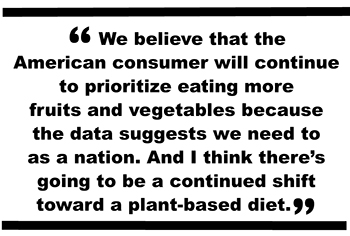
I also think that when I look at our industry overall, there’s incredible value that we are creating as an industry, particularly for consumers. I’m not sure we do a great job of capturing that value as a whole, and so there’s an interesting gap there. You look at the U.S. overall, right, and when you look at how much we spend on food, it’s incredibly low compared to other nations. And so I think that there’s going to need to be some acknowledgement that food, good food, healthy food, costs money. There’s got to be a willingness to pay for it. And there’s got to be a willingness to deliver the right quality and the right health characteristics on the supply side.
Q: Well, let’s hope you’re right on that and I’ll be voting for it. I know you’re very busy, Ted, and have a lot going on out there. I want to thank you for taking a moment to speak with us here today. Next year, we’re going to get you to the New York Produce Show and Conference live. And in the meantime, we thank you very much for joining us today. We really appreciate it.
A: Thanks for having me, Jim. Really appreciate it.
******
It is interesting that the younger the person, the less jaded they are and are less set in the old way… and so the more plausible it is to imagine life proceeding differently. Ted has young children and, of course, this is their life too.
You know when Ted talks about the Taylor Farms family of 22,000 employees, it makes us want to apply for a job and petition to be accepted as part of that family. We talk to many, many executives, and some don’t believe in that family business philosophy. Some belive but don’t have the resources to execute the strategy on such a massive scale.
It is, of course, interesting to hear Ted discuss the strategy of one of the trade’s premier companies during the pandemic, but maybe it is more valuable to engage with the thoughts of a young man seriously wrestling with the future. Think about Ted’s closing lines:
“I also think when I look at our industry overall, there’s incredible value that we are creating as an industry, particularly for consumers. I’m not sure we do a great job of capturing that value as a whole, and so there’s an interesting gap there. You look at the U.S. overall, right, and when you look at how much we spend on food, it’s incredibly low compared to other nations. And so I think that there’s going to need to be some acknowledgement that food, good food, healthy food, costs money. There’s got to be a willingness to pay for it. And there’s got to be a willingness to deliver the right quality and the right health characteristics on the supply side.”
Think about that for a moment. Ted is challenging the industry to persuade the citizenry of America as to the importance of good quality food and urging people to recognize its value. Yet he also challenges the industry to deliver on the value: To offer the highest quality and commit to selling products that deliver on the health side.
Beyond the problems of the pandemic, produce has had challenges. Per capita consumption has not been rising. Yet, with young leaders thinking like this, one imagines a bright post-pandemic experience for the industry. We thank Ted, and Taylor Farms, for being willing to speak out about the challenges and opportunities presented for a post-pandemic industry.
